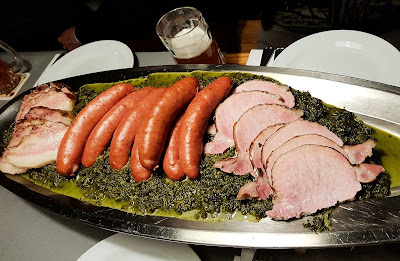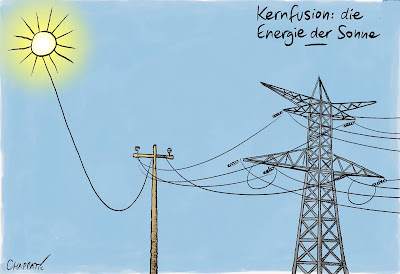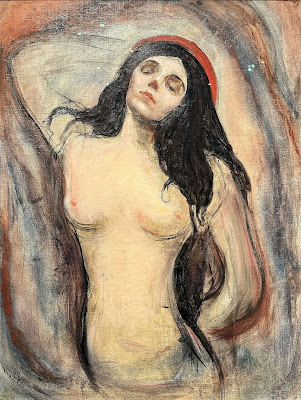But why was there suddenly something about Lina in three different articles?
It was about her involvement in the Nazi regime.
Lina was born in 1851, so I wondered what an old lady of 82 had to say about the 3rd Reich.
In fact, she greeted the Machtergreifung (seizure of power) by the Nazis in 1933 with a "sieghaften Heil auf unseren Volkskanzler, der die Deutschen aus der Verbundenheit mit der Natur heraus gesunden lassen will (victorious Heil to our People's Chancellor, who wants to make the Germans healthy out of the bond with nature)."
It was a recurrence of the right-wing position after the lost First World War when the Vogelschutzbund warned in 1919 against domestic "Schädlinge (pests)" that had to be driven back so that "sie nicht mehr den ganzen Organismus vergiften können (they could no longer poison the whole organism)."
Consequently, in 1934, the BfV amended its statutes, according to which, in the future, only "deutsche Staatsangehörige deutschen oder artverwandten Blutes (German citizens of German or kindred blood)" could become members.
In 1990, the BfV became Germany's Naturschutzbund (Nabu; Nature Conservation Union).
To mark the 75th anniversary of Lina Hähnle's death, Nabu held a conference in February 2016 entitled "Lina Hähnle und die demokratischen Traditionen im deutschen Naturschutz (Lina Hähnle and the Democratic Traditions in German Nature Conservation)." At the time, the head of Nabu's president office said, "Wir wollen auf das soziale und demokratische Engagement von Hähnle und ihrer Familie aufmerksam machen (We want to draw attention to the social and democratic commitment of Hähnle and her family)."
Lina was born in 1851, so I wondered what an old lady of 82 had to say about the 3rd Reich.
In fact, she greeted the Machtergreifung (seizure of power) by the Nazis in 1933 with a "sieghaften Heil auf unseren Volkskanzler, der die Deutschen aus der Verbundenheit mit der Natur heraus gesunden lassen will (victorious Heil to our People's Chancellor, who wants to make the Germans healthy out of the bond with nature)."
It was a recurrence of the right-wing position after the lost First World War when the Vogelschutzbund warned in 1919 against domestic "Schädlinge (pests)" that had to be driven back so that "sie nicht mehr den ganzen Organismus vergiften können (they could no longer poison the whole organism)."
Consequently, in 1934, the BfV amended its statutes, according to which, in the future, only "deutsche Staatsangehörige deutschen oder artverwandten Blutes (German citizens of German or kindred blood)" could become members.
In 1990, the BfV became Germany's Naturschutzbund (Nabu; Nature Conservation Union).
To mark the 75th anniversary of Lina Hähnle's death, Nabu held a conference in February 2016 entitled "Lina Hähnle und die demokratischen Traditionen im deutschen Naturschutz (Lina Hähnle and the Democratic Traditions in German Nature Conservation)." At the time, the head of Nabu's president office said, "Wir wollen auf das soziale und demokratische Engagement von Hähnle und ihrer Familie aufmerksam machen (We want to draw attention to the social and democratic commitment of Hähnle and her family)."
On the occasion and in contrast, Andreas Speit wrote an article in the taz, "NS-Geschichte des Nabu: Die braune Vogelschützerin (NS History of Nabu: The Brown Bird Protector)." His conclusion: Hähnle had acted "nach außen nicht nur kritiklos, sondern unterstützend und bejahend (outwardly not only uncritically, but supportively and affirmatively)."
"In the person of Lina Hähnle is depicted how National Socialism instrumentalized nature conservation and used it as a gateway into a partly quite skeptical milieu." In the end, Hähnle does justice to "neither uncritical remembrance nor discrediting," i.e., the Vogelmutter (Mother of the Birds) is ambivalent.

|
| Lina-Hähnle-Path in Freiburg-Weingarten (©Andreas Schwarzkopf†/Wikipedia) |
What a balancing act. The commission members confronted with the facts, no longer remember how their unclouded classification came about.
The then chairman of the commission, Bernd Martin, wrote, "As far as I remember, I never had anything to do with the Hähnle matter." The historian Volker Ilgen, who was commissioned to do the research, said he can no longer recall the decision-making processes because of the abundance of names and the long time that the commission's work goes back, "I also no longer have any documents; and besides, I have neither the time nor the inclination to deal with the subject."
In the meantime, the dust has settled a bit. After all, the Freiburg Street Naming Commission had pointed out in its final report that it could not be its goal to cleanse the "history of the dark stains" that can also express themselves in street names. It is always necessary to "weigh up political-ideological entanglements and merits," to "understand people in their historical context," and to assess "whether their support of the Nazi injustice state, for example, went beyond being a fellow traveler."
And Nabu also responded, "The image we have of Lina Hähnle has 'many shades of gray.' Hähnle had a stabilizing effect on the system during National Socialism 'with her like-minded association.'"
Finally, Lina fulfills the Jerry Coyne criteria, and therefore she should not be canceled.
Thus a renaming of the Lina-Hähnle-Path remains probably spared. Still, besides the explanation, "Foundress and First
Chairwoman of the Federation for the Protection of Birds," the street sign would require a further addition.
Today, December 31, is unique. I do not mean the traditional firecrackers on New Year's Eve, which after two years of prohibition because of Corona, now again allow Germans to welcome the new year with noise. I instead regard the temperature forecasts of today.
While in the States, the great thaw of the enormous snow masses continues, in Freiburg, the temperature is expected to reach 19 °C (66 F), the highest temperature recorded so far in Germany on New Year's Eve. As a precaution, Red Baron has eyed his T-shirts.

|
| Peaceful Lina-Hähnle-Weg (©Michael Bamberger/BZ) |
Today, December 31, is unique. I do not mean the traditional firecrackers on New Year's Eve, which after two years of prohibition because of Corona, now again allow Germans to welcome the new year with noise. I instead regard the temperature forecasts of today.
While in the States, the great thaw of the enormous snow masses continues, in Freiburg, the temperature is expected to reach 19 °C (66 F), the highest temperature recorded so far in Germany on New Year's Eve. As a precaution, Red Baron has eyed his T-shirts.
I wish all my readers a Happy but, above all, Healthy New Year.


























































